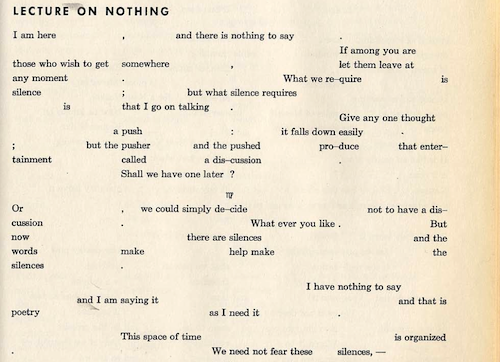Functional White: Crafting Space & Silence
The white space is just as important as the text in a poem, whether it’s the counter that shapes an O or S, a line break after a word or a caesura within a line. With space, one can shape sound and language to create a poetic field. And with that, one may express a silence. When we write or type, our focus seems to be on a small percentage of the paper, which is, where the text is placed. But around it there lies a pause, a momentary rest that hibernates. Much like a semibreve rest within a measure or like a crease pattern after unfolding a sheet of paper: space holds rhythm and structure. Plus, what are letters, words, punctuation, and sentences without the music and form of the page? A particular text that comes to mind is “Lecture On Nothing” by John Cage in which he composes measures of white space:

In his introduction to the lecture he emphasizes how to read the text by saying, “this should not be done in an artificial manner (which might result from an attempt to be too strictly faithful to the position of the words on the page), but with the rubato which one uses in everyday speech.” In a way, Cage reminds us not to depend on language but rather to consider the cadence of line in relation to the page’s expanse. Where the paper and body and ink and breath exist simultaneously in order to create a literary moment for the writer. That connection between poet and page becomes proportional to each other. Where symmetry occurs in that instant you ascend then descend and finally crossbar the A; your hand is the letter along with your body synchronizing with ink and vice versa. Because there is a pulse in the human figure, there is pulse within the folio as well; the poetic existence in space between the written language is the vital sign of silence.
Designers of publications refer to the white spaces of the page as functional white. Functional white guides the reader through a text; white space allows text to exist in a specific position on the page in relation to the background. And perhaps that background is the throat of paper, inhaling language and exhaling sound and silence. Like Inuit throat singers, when the page and poet are face-to-face, close enough for both their lips to meet, their breaths subsist off each other. And in an instant, that natural ornate experience blends person and page. The line and its breath, with its origin from the lung of the page, is caesuric, as we (poets) are too. Because pauses construct the spaces which interweave letters, words, and thoughts on a sheet of paper. Though silence on the page develops habitually from our use of techniques as poetry writers, sometimes being aware of the white spaces, rather than concerning ourselves with punctuation and language, allows us to experience the silence personally. Perhaps text sometimes acts as a polarizing filter that darkens the paper and dims the brightness of the page. So it’s up to us, the poets, to write and un-write and interpret and re-interpret the page through space by making language and silence collaborate. Because there is another rhythm waiting to reawaken from the depths of the page and we, poets, should construe and create the pause before and during the reading and writing of a poem.
Poet Orlando White is from Tólikan, Arizona. He is Diné of the Naaneesht’ézhi Tábaahí and born for the...
Read Full Biography

